Smoothhounds: Family Triakididae
Species: Triakis semifasciata from the Greek word tria (meaning the number three, like a triad) and Latin cis (meaning on the side), and the Latin fasciata (bundled) referring to the stripes.
Alternate Names: Cat shark or (mistakenly) tiger shark. Called tiburón leopardo in Mexico.
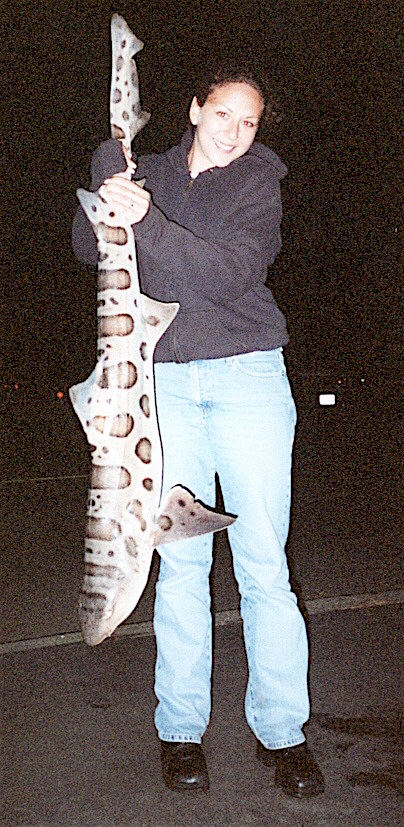
Leopard Shark caught by DolphinRider aka Lisa at Berkeley
Identification: Leopard sharks have a dark gray body (some are almost bronze or golden brown) with black bars (saddles) and spots, and are one of the prettiest sharks. Their first dorsal fin is in advance of the pelvic fins; the base of the second dorsal is in advance of the base of the anal fin. They have a long, pointed snout with oval eyes and nictitating membranes. The mouth is equipped with a fine array of small but sharp pointed teeth.
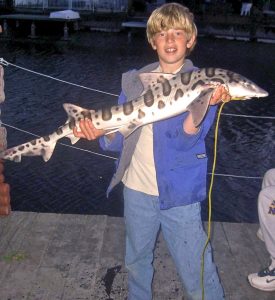
Leopard shark caught by Minnow Magnet (Justin Morris)
Size: Length to 7 feet and nearly 70 pounds; most caught off piers are less than four feet in length. The California record fish weighed 47 lb 1 oz and was taken off Palos Verdes, Los Angeles Co. in 2007.
Range: From Mazatlán, Mexico, the Gulf of California, Isla Guadalupe, Baja, California to California and Oregon. Common from the Gulf of California to Coos Bay, Oregon.
Habitat: Most leopards are caught in bays but many are also caught in shallow, sandy-shore areas; they make an annual migration from the bays to the outer coast. Large schools mixed with smoothhound sharks are common in shallow water. Typical foods include large crustaceans and small fish. Found from the surf zone down to about 500 feet.
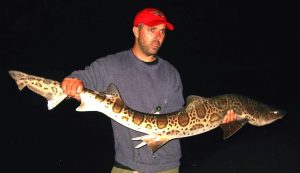
Leopard shark caught at the Malibu Pier
Piers: Caught at virtually every California pier and a major pier species in San Francisco Bay and Humboldt Bay. Best SoCal piers: Imperial Beach Pier, Ocean Beach Pier, Crystal Pier (San Diego), Shelter Island Pier (San Diego), Oceanside Pier, San Clemente Pier, Huntington Beach Pier, Hermosa Beach Pier, Manhattan Beach Pier, Malibu Pier, Ventura Pier, Goleta Pier and Gaviota Pier. Best CenCal piers: Avila Pier, Cayucos Pier, and Morro Bay T-Piers. Caught at basically every San Francisco Bay pier. Best bets: San Francisco Municipal Pier, Pier 7 (San Francisco), Candlestick Park Pier, Oyster Point Pier, Port View Park Pier (Oakland), Berkeley Pier, Ferry Point Pier (Richmond), Marin Rod and Gun Club Pier, Elephant Rock Pier, Angel Island Pier, Fort Baker Pier. Best NorCal piers: most piers in Humboldt Bay offer excellent fishing for leopard sharks (especially at night).
Bait and Tackle: Will take almost any bait but prefers squid, an oily fish like mackerel or anchovy, or live baits such as ghost shrimp or small fish. If specifically fishing for leopard sharks, use medium tackle, a size 2 to 4/0 hook, and heavy monofilament line – together with a net to bring the fish up onto the pier. Late summer and fall finds best fishing in the San Francisco Bay Area.
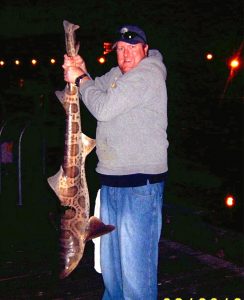
Leopard shark caught by CayucosJack (Aaron Coons) at the Morro Bay North T-Pier
Food Value: An excellent, mild flavored flesh that can be fried, broiled or baked; considered one of the best eating sharks. Like all sharks, it should be bled and cleaned as soon as possible. It should also be kept cool and an overnight bath in the refrigerator (with just a couple of squirts of lemon juice) helps assure the good flavor.
Comments: This is one of the favorite sharks for most pier fishermen; it is attractive, reaches a good size, puts up a good fight, and is good eating. They also make great aquarium fish—until they begin to grow too big.
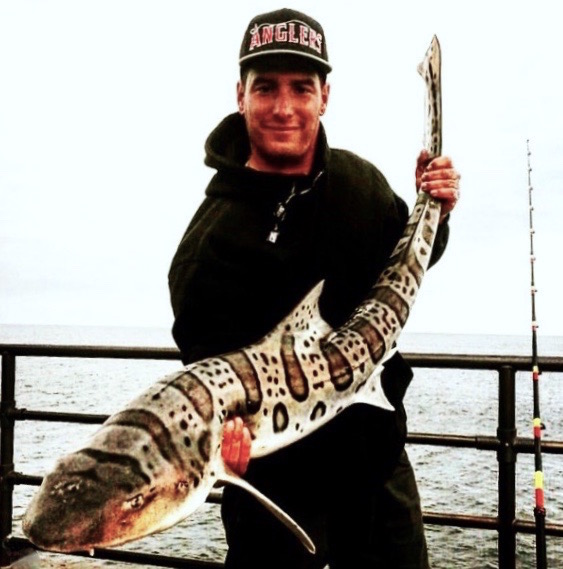
Leopard Shark caught at the Huntington Beach Pier
Perhaps one of the strangest stories concerning the fish had to do with the Unification Church (the Moonies) and how one of its pastors became the largest poacher of baby leopard sharks in history. Reverend Kevin Thompson of San Leandro’s “Bay Area Family Church”—and his “Ocean Church” fishing ministry—were accused of poaching roughly six thousand baby leopard sharks between 1991 and 2004. Thompson would pay fishermen $2 to $3 per pup then sell them to dealers for $20-$35. The dealers in turn were able to sell the pups for as much as $450 to customers throughout the U.S., Great Britain and the Netherlands. The estimated street value of the pups was $1.2 million dollars and a half dozen people were eventually indicted by a Grand Jury in Oakland. Thompson faced eight years in prison if convicted of the charges. Sounds a little light to me.
Of note is a study conducted on surf species by the Fish and Game Department between 2007-2009 in the Bolsa Chica to Hermosa Beach area (SoCal). The study showed an increase in the number of leopard sharks from the 1990s and that leopard sharks were “much more abundant in the current study than in the 1950s.” Cool!
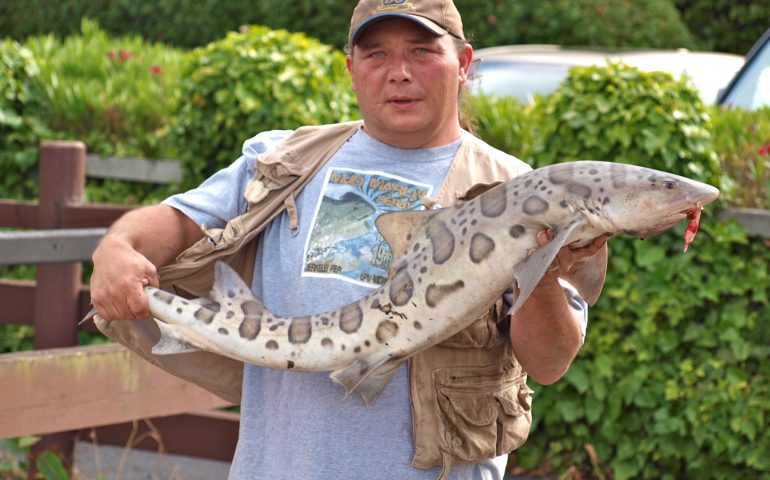
Enjoyed Reading ThankYou For Sharing Such An Great Post Enjoyed Reading The Post
Great article! It’s fascinating to learn more about the leopard shark’s habitat and behavior, especially its popularity among pier anglers in California. The tips for spotting them and the fishing techniques mentioned are really helpful. It’s also great that the article highlights conservation issues and the importance of responsible fishing practices. I’ll definitely keep an eye out for them next time I’m fishing at the pier! Thanks for the insight!
Wow! Each of one has a huge catch!
Wow, Leopard Sharks are fascinating creatures! It’s amazing to learn about their unique patterns and behavior. If you’re into discovering cool apps or MOD games, feel free to check out LionModAPK. They have a great selection of free APKs and MODs for Android. Keep up the awesome work with these informative posts!
“Wow, the leopard shark is such an interesting species! It’s amazing to learn more about these incredible creatures. By the way, if you enjoy Instagram content, VidInsta is a great tool to quickly download videos, reels, photos, and stories from Instagram. It even lets you convert them to Instagram MP4 format. Definitely worth checking out if you want to keep your favorite posts!
Incredible post! Your ability to articulate complex ideas in such an accessible way is truly inspiring. accessible way is truly inspiring. I can’t wait to apply some of these takeaways in my own work. If you’re interested in exploring more content like this, I’d love to invite you to check out my website FuboTV offers various add-ons including premium channel packages like Paramount+ with SHOWTIME, MGM+, and STARZ, as well as sports add-ons such as NBA League Pass, Sports Plus with NFL RedZone, and MLB.TV
Wow, a Leopard Shark catch is definitely something exciting! These sharks are known for their beautiful patterns and generally calm nature. Always fascinating to see marine life up close—hope it was released safely!
Really enjoyed this write-up! Leopard sharks are one of my favorite catches off the pier — always exciting when one shows up.
I liked the breakdown on locations and bait options, especially the reminder about ghost shrimp.
Appreciate how informative and well-written this was. Thanks for sharing!
Really enjoyed this write-up! Leopard sharks are one of my favorite catches off the pier — always exciting when one shows up. I liked the breakdown on locations and bait options, especially the reminder about ghost shrimp. Appreciate how informative and well-written this was. Thanks for sharing!
Really enjoyed this post – leopard sharks are such fascinating creatures, and your insights make them even more interesting to learn about! I’ve been watching some marine life videos lately, and I use Vidfrom.com to convert them into YouTube MP3 so I can listen while out fishing or just relaxing. Super handy for nature lovers!